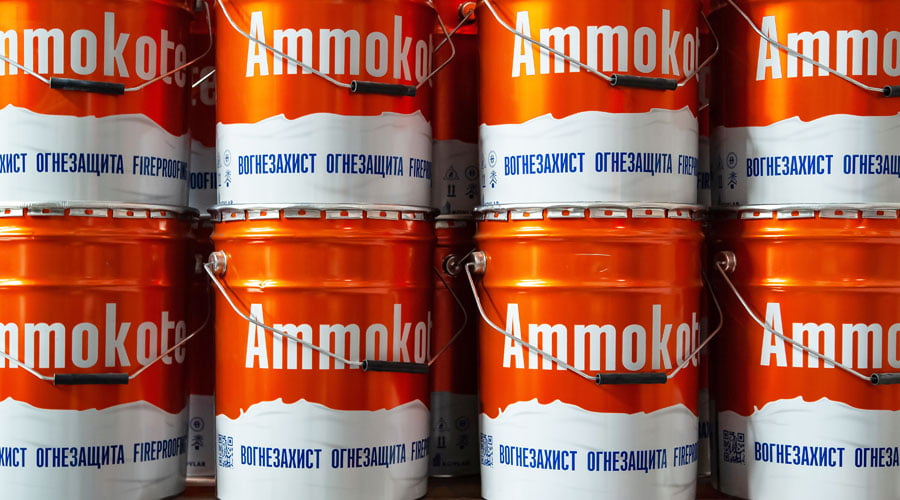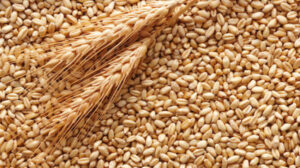
If hostilities end in 2025, Ukraine’s passive fire protection market could grow approximately 2.5 times from 2026 to around $25 million, according to Kovlar Group, a manufacturer of passive fire protection products.
According to the company’s experts, based on the preliminary results of the Ukraine Recovery Conference 2025 (Rome) and taking into account the priority tasks for reconstruction, a change in the segmentation of the passive fire protection market by type of material is expected. Intumescent coatings for steel will account for the largest share — 35-40%, fire-resistant plasters and slabs — 20-25%, sealing systems for penetrations and protection of engineering communications — 25-30%, materials for wood protection — up to 10%, and ventilation and smoke ducts — 5-10%. There is also a forecast for growth in demand for epoxy and polyurethane fire protection systems for oil and gas infrastructure, energy, and strategic facilities, which was previously limited by the high cost of imported analogues.
Konstantin Kalafat, director of Kovlar Group, emphasized that domestic manufacturers have sufficient capacity to ensure large-scale reconstruction of the country’s infrastructure in the post-war period. In particular, Kovlar Group LLC prioritizes the restoration of the energy sector, where the speed of work, availability of materials, and increased fire safety requirements are crucial.
“The use of Ammokote products ensures the efficiency of fire protection work — our own production reduces logistics times and allows us to quickly deliver large volumes. Local production reduces the cost compared to imported analogues, which is especially important for large-scale restoration projects,” said Konstantin Kalafat, director of the company.

An important factor for reconstruction is the implementation in Ukraine of the law “On the Provision of Construction Products on the Market,” which implements the provisions of Regulation (EC) No. 305/2011 and is expected to increase the competitiveness of the Ukrainian fire protection segment in comparison with European products. According to Konstantin Kalafat, Ukrainian manufacturers of fire protection products should actively implement manufacturing and product control technologies in accordance with advanced European standards.
A critically important area of the company’s activity is fire protection of cable lines at energy facilities, where fire safety is a prerequisite for the reliable and uninterrupted operation of power generation, substations, and networks. Kovlar Group offers comprehensive solutions for cable protection: fire-retardant paints, plasters, three types of systems for penetrations, as well as special couplings, seals, and sealants. In the first half of 2025, the company developed Ammokote TOP-W, a universal finishing material for cable communication fire protection systems; certification of Ammokote EP epoxy fire-retardant paint is ongoing.
“The company adheres to transparent competitive procedures and is ready to work within the framework of open tenders, cooperate with government agencies, contractors, and project teams for prompt, safe, and economically sound reconstruction,” emphasized Konstantin Kalafat.
Kovlar Group LLC was founded in 2015 in Kyiv and is the largest manufacturer of passive fire protection products in Ukraine. According to OpenDataBot, the company’s authorized capital is UAH 1.2 million, and its ultimate beneficiaries are Kostyantyn Kalafat (40%), Andriy Ozeychuk (35%), and Lyubov Vakhitova (25%). The company’s revenue for 2024 was UAH 91.3705 million, which is twice as much as in 2023, and its net profit was UAH 13.4 million, which is 1.7 times more than in 2023. In the first quarter of 2025, the company’s revenue was UAH 13.5 million, with a net income of UAH 1,983,000.
Source: https://interfax.com.ua/news/economic/1101227.html

As part of a public-private partnership program, trading company Almeida Group LLC has signed a long-term lease agreement for the Bogdanivets Grain Processing Plant (Khmelnytskyi region) and increased its storage capacity by 92,000 tons, according to company director Maksym Volchenko.
“Thanks to the implementation of this project, Almeida Group has already exceeded its simultaneous storage capacity figures that were in place before the full-scale invasion,” he wrote on Facebook.
According to Volchenko, the Bohdanivets Bread Products Plant property complex includes an elevator with a total storage capacity of 92,000 tons, four independent grain receiving points from motor vehicles with a capacity of 3,000 tons per day, two grain drying complexes, a laboratory certified for all crops, railway infrastructure, and a mill with a capacity of 120 tons per day.
During August 2025, Almeida Group LLC carried out pre-season repairs and calibration of all equipment at the elevator complex, assembled a highly qualified team of company specialists, resolved a number of issues related to railway infrastructure, repaired a diesel locomotive, and restored access to the railway.
“As a result of this partnership, the Almeida Group has further increased its presence in the region in the elevator, trading, and logistics sectors, as well as gained another foothold for creating supply chains from producers to European and other export markets,” said the head of the enterprise.
Volchenko added that local producers now have the opportunity to order storage, laboratory control, and logistics services for the export of agricultural products with a full delivery cycle to ports or to European Union countries by land and water at rates that are attractive to agricultural producers.
Almeida Group LLC was registered in 2008. It specializes in the purchase and wholesale of grain crops and international transport and logistics services. It has six regional offices with its head office in Kyiv: in Kharkiv, Chernihiv, Chernivtsi, Uzhhorod, and Lviv.
Before the war, the company used a transshipment hub-elevator in Severodonetsk (Luhansk region). It has now been destroyed. In 2022, Almeida Group built a transshipment complex on the border with the EU at the Vadul-Siret station and resumed trading in grain crops.
In 2023, it built similar transshipment complexes at the Chop station (Zakarpattia region) and the Mostyska station (Lviv region). In 2025, the company took over the management of the Rozdorsky elevator from the G.R.Agro group.
In 2024, the USAID Economic Support to Ukraine Project purchased and transferred 25 new grain cars to Almeida Group LLC to increase agricultural exports.
The beneficiaries of Almeida Group are Mikhail Kudukhashvili and the owner of Levada Agricultural Production Cooperative, Maxim Volchenko.
Almeida Group, Bogdanivets Agricultural Production Cooperative, GRAIN

Issue #2 – August 2025
The purpose of this review is to provide an analysis of the current situation on the Ukrainian foreign exchange market and a forecast of the hryvnia exchange rate against key currencies based on the latest data. We analyze current conditions, market dynamics, key influencing factors, and likely scenarios.
Analysis of the current situation on the Ukrainian currency market
In the second half of August, a number of important signals from global markets confirmed that the hryvnia exchange rate increasingly depends not on local factors but on international news and the state of the world’s leading economies and the decisions of their central banks.
Domestic factors remain rather short-term impulses, capable of producing slight spikes but not changing the overall trajectory.
International context
In the United States, July data showed a slowdown in inflation and a cooling of the labor market. This took some pressure off the dollar and increased expectations that the Federal Reserve could cut rates as early as September. The Fed chairman explicitly acknowledged that the policy will have to be reviewed in order not to “overstretch” the economy. As a result, the dollar weakened slightly, and stock markets got a chance for additional optimism.
Given the expectations of the Fed’s actions regarding rate revisions, different scenarios should be considered for key currency pairs.
If the Fed cuts rates in September:
If the Fed leaves the rate unchanged:
The European economy looks sluggish: growth is almost imperceptible, inflation is stable at 2%, and there are no new drivers for the euro. This keeps the currency in a neutral mode – no reason for a breakthrough, but also no prerequisites for a sharp fall.
The UK was the first major economy to cut its interest rate. This signaled to the world that the period of tight monetary policy is coming to an end. If the United States confirms a similar move, the yield differential between currencies will decrease, and the dollar will lose some of its advantage.
Oil and gas prices remained relatively calm in August. This means that there is no additional pressure on the US and European economies due to energy. This is even more of a disadvantage for the euro, as the argument for a tighter ECB policy disappears.
In general, the international backdrop looks like this: The dollar has temporarily lost some of its support, and the euro is hovering on the sidelines.
For the hryvnia, this means relatively stable conditions.
Domestic Ukrainian context
The NBU’s reserves remain high, even after significant interventions and external debt repayments. This creates a safety margin to smooth out exchange rate fluctuations.
In July, inflation eased to 14.1% year-on-year, and the monthly figure showed deflation for the first time in two years. This calmed the market and reduced the “insurance premium” in prices.
External support is coming in as planned: at the end of August, the next tranche of more than €3 billion under the Ukraine Facility program and €1 billion from the proceeds of frozen Russian assets under the G7 Extraordinary Revenue Acceleration for Ukraine (ERA) initiative were disbursed. This is an important stabilizing factor for both the budget and the FX market.
The NBU has also taken steps to liberalize the currency by allowing the repatriation of dividends and expanding hedging instruments. This creates a more predictable environment for business without putting any additional pressure on the exchange rate.
In general, the Ukrainian FX market is entering September in a calm mode: reserves are sufficient, inflation has cooled, and external funds are coming in at the right level.
Internal factors are rather short-term spikes, but the exchange rate will be determined by statements, events, and decisions from Washington and Brussels.
US dollar exchange rate: dynamics and analysis
The general characteristic of market behavior is a smooth decline without sharp impulses
August confirmed the trend of gradual depreciation of the dollar against the hryvnia.
Domestic demand remains restrained: importers are working as planned, households are mainly focused on the euro, and the NBU is keeping the exchange rate in balance without any sudden movements.
Key influencing factors:
Forecast:
Euro exchange rate: dynamics and analysis
General characteristics of market behavior
The end of August showed more volatility for the euro than for the dollar. During the week, the exchange rate initially declined (to lows of ~47.80 UAH/€ on the buy side and ~48.40 UAH/€ on the sell side on August 27-28), but recovered to the level of 48.20-48.60 UAH/€ at the end of the period (August 30-31). It was a technical rebound that was synchronized with movements in the EUR/USD pair on the global market after the Fed chairman’s statement.
Prior to the news from the US, the market had recorded a stabilization in the euro after the previous decline, but there were no drivers for a new trend or significantly different levels from the current target levels.
Key influencing factors
Forecast.
Recommendations: act in ranges, keep liquidity, hedge risks
Key universal ideas:
A universal strategy for everyone – flexibility, division of operations into parts, hedging.
For private investors and savers:
For speculative operations on USD/UAH and EUR/UAH:
This material was prepared by the company’s analysts and reflects their expert, analytical professional judgment. The information presented in this review is for informational purposes only and cannot be considered as a recommendation for action.
The Company and its analysts make no representations and assume no liability for any consequences arising from the use of this information. All information is provided “as is” without any additional warranties of completeness, obligations of timeliness or updates or additions.
Users of this material should make their own risk assessments and informed decisions based on their own evaluation and analysis of the situation from various available sources that they consider to be sufficiently qualified. We recommend that you consult an independent financial advisor before making any investment decisions.
REFERENCE
KYT Group is an international multi-service product FinTech platform that has been successfully operating in the non-banking financial services market for 16 years. One of the company’s flagship activities is currency exchange. KYT Group is one of the largest operators in this segment of the financial market of Ukraine, is included in the list of the largest taxpayers, and is one of the industry leaders in terms of asset growth and equity.
More than 90 branches in 16 major cities of Ukraine are located in convenient locations for customers and have modern equipment for the convenience, security and confidentiality of each transaction.
The company’s activities comply with the regulatory requirements of the NBU. KYT Group adheres to EU standards, having a branch in Poland and planning cross-border expansion to European countries.
https://interfax.com.ua/news/projects/1101270.html

The volume of raw milk supplied for industrial processing in January-June 2025 exceeded 1.8 million tons, which is 10.6% more than in the same period of 2024 and 19.3% more than in the same period of 2023, according to the Ukrainian Dairy Industry Association (UDIA).
The industry association emphasized that the growth rate of raw milk purchases from enterprises in the first half of 2025 decreased to 6% compared to 12.6% in the first half of 2024.
“Raw milk supplies from private farms amounted to less than 94,000 tons,” the UDAU stated.

Hungarian Foreign Minister Péter Szijjártó said that Budapest and Belgrade have agreed to speed up the construction of an oil pipeline between the two countries. The 190 km Hungarian section is planned to be completed by the end of 2027, according to the Serbian Economist Telegram channel.
“We have agreed with Serbian Energy Minister Dubravka Jedovic-Handanovic to speed up the construction of the oil pipeline between Hungary and Serbia. The 190 km Hungarian section should be completed by the end of 2027,” he said on social network X, emphasizing the importance of energy cooperation against the backdrop of Ukraine’s attacks on the Druzhba oil pipeline, which supplies oil to Hungary and Slovakia, among other countries.
Why the project is important for these countries and the entire Balkan region
Increased energy security and diversification of routes
The new oil pipeline will reduce Hungary and Serbia’s dependence on traditional routes, especially in the context of instability caused by damage to Druzhba. This increases the reliability of supplies and reduces energy risks.
Regional energy integration
The construction of infrastructure connecting the Balkan and Central European regions helps strengthen economic ties and stimulates the growth of the energy market in the region.
Strategic independence
Independence from single transit routes provides greater flexibility in times of crisis and allows countries to respond more quickly to external challenges.
Economic impact and infrastructure development
The project creates jobs, contributes to the development of transport and energy infrastructure, and attracts investment for both Hungary and Serbia.
Geopolitical stability in the Balkans
The Balkan region has traditionally been at the crossroads of geopolitical interests. The new route strengthens its strategic importance and helps reduce dependence on external factors.
The Hungarian-Serbian oil pipeline project is not just a technical initiative. It serves as the foundation for a new energy architecture in the region, creating a sustainable, independent, and mutually supportive security system, which is particularly relevant in light of current geopolitical realities.
Source: https://t.me/relocationrs